Do you know how to hold a dog leash correctly?
You’d be amazed to learn how many experienced dog owners have no idea how to properly hold their pup’s leash. But why is it important to hold the leash correctly? And how should a dog leash be held?
Read this guide to learn how to hold a dog leash like a pro!
How To Hold A Dog Leash
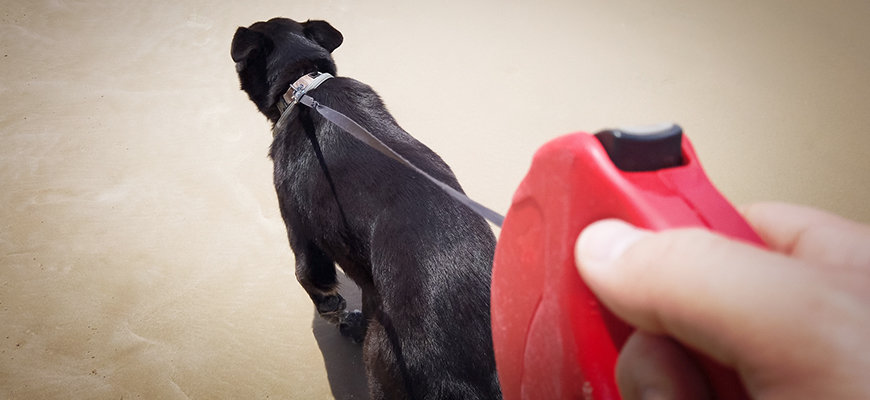
Holding your dog’s leash correctly can help keep you and your furry friend safe when you’re out and about.
Retractable Dog Leashes
Retractable leashes are long leashes up to 26 feet in length attached to a spooling mechanism inside a plastic handle. You simply hold the handle with its ergonomic grip.
The handle has a button that you press to release the leash to allow your dog more space to walk or recoil the leash when the dog comes back to you.
This kind of leash is not suitable for dogs that pull or are not trained to walk obediently on a loose leash. An unruly dog on a retractable leash can be dangerous.
The leash could become tangled around you, your dog, a stranger, a stranger’s dog, a tree, a fire hydrant, etc. If the dog lunges forward and tugs the leash handle from your grasp, your pet could get loose and run out into a busy road.
There have been occasions when a dropped retractable leash handle has reeled in the leash cord at high speed, hitting the dog on the head and causing serious injuries.
Leash Handling Methods
There are quite a few effective methods of holding a dog leash that is used by dog trainers, including:
- thumb grip
- pointed finger grip
- accordion grip
- double loop grip
- body anchor
- double leash lock-off
- hands-free leash
The kind of grip you choose is really a matter of personal preference and whatever suits your dog best.
1. The Thumb Grip
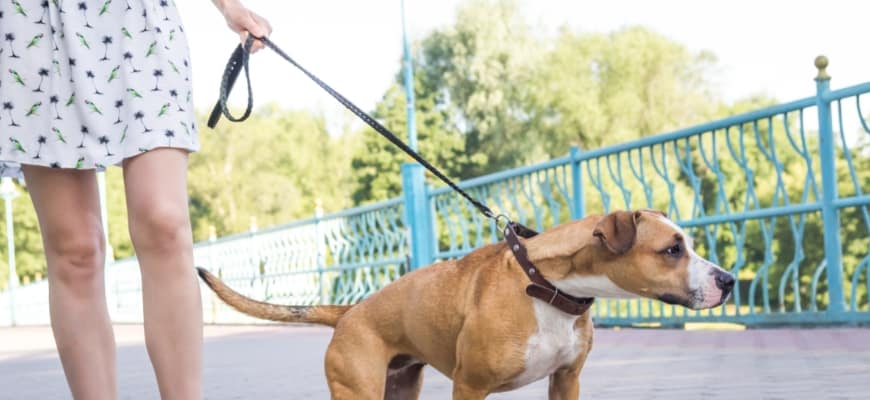
The thumb grip is a very popular way of holding your dog’s leash. This grip is the perfect method for you if you want your dog to walk on the opposite side of your body from your anchor hand.
- Put your thumb through the loop of the leash handle.
- Gather some slack in the leash and loop it over your thumb again.
- Now, close your fist, trapping all the leash layers inside it, and place your thumb across the top. The remainder of the leash cord should leave your hand on the pinky side, creating an anchor.
You can alter how much leash length is available for your pup to use with the position of your second hand. It’s not necessary to hold the dog too close to you, but you will want to gather up sufficient slack in the leash so that the dog doesn’t accidentally step over it. The leash should leave both your hands on the pinky side.
To provide your dog with a bit more slack, simply open up your anchor hand by pointing your thumb upwards and allow as much slack as you want. Because the leash handle is wrapped around your thumb, you won’t drop the leash.
To hold onto your pet more tightly, hold the leash in both hands close to your navel as if you were holding a baseball bat.
2. Pointer Finger Grip
The pointer finger grip works in a similar way to the thumb grip in that you place your thumb through the leash’s loop handle.
- Pick up some slack in the leash and form a loop over your first finger, rather than your thumb, of the same hand.
- Take all the leash layers in your fist, keeping your thumb on top and the leash, leaving your hand on the pinky finger side. That forms your anchor.
- If the dog needs more slack, open the anchor hand with your thumb uppermost. Close your fist around the leash handle to re-establish the anchor.
This grip is a good method for people who want to walk their pup on the same side of their body as their anchor hand.
3. The Accordion Grip
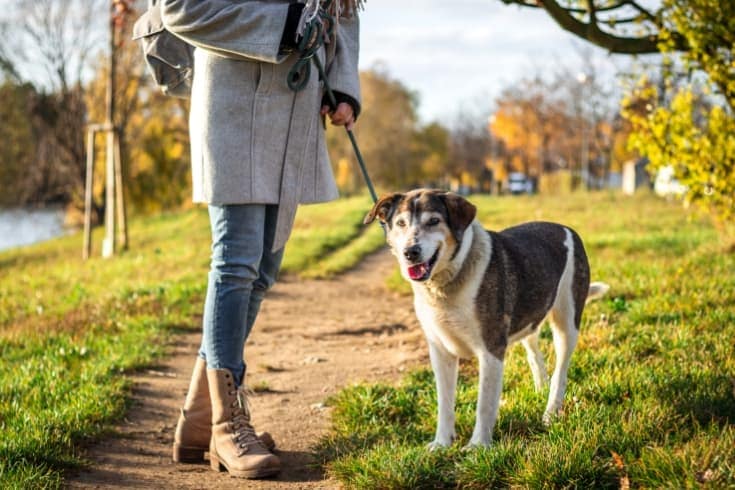
The accordion grip entails the leash loop being wrapped around your four-finger knuckles and placed over your thumb.
You layer the leash back and forth a few times across your palm and grip it with your fist. The remaining length leaves your hand on the pinky side toward your canine companion to form your anchor.
You can use your other hand to hold some of the remaining leash slack if you like to have your dog walk on the opposite side of your body from your anchor hand.
The accordion grip best suits people who want to switch and leash from one side of the body to the other as they walk since the leash isn’t looped around your fingers.
4. Double Loop Grip
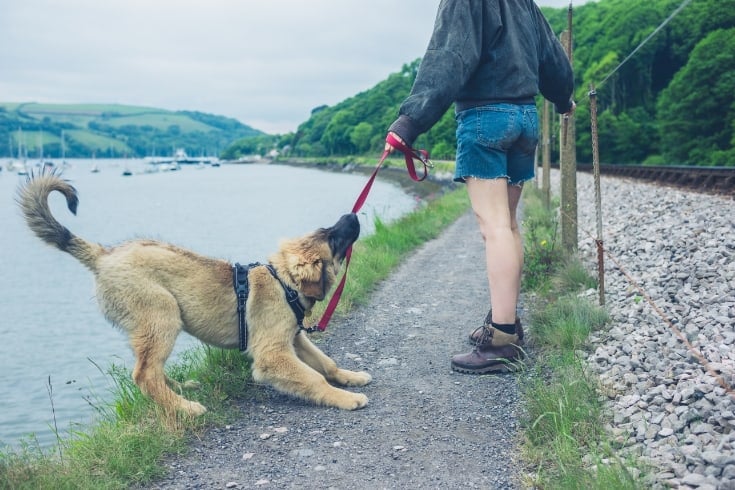
The double loop pattern method is a hold that’s safer than wrapping your dog’s leash around your whole hand.
Essentially, you loop the leash over your index finger twice, secure the leash with your thumb, and form a fist.
5. The Body Anchor
To use the body anchor grip, you need to find your center of gravity, which is usually between your mid-core and hips.
- Grip the leash with both hands, with the hand farthest from your dog placed firmly against the small of your back.
- Twist your hips, and lean slightly backward.
That tensions the leash on your body, saving your arms from taking the strain. This grip can be extremely useful if you have a dog that’s a very hard puller.
6. The Double Leash Lock-Off
The double leash lock-off requires two leashes, a dog harness and a collar.
- Fix the back leash to a stake or something heavy.
- Attach the leash to your dog’s harness.
- Fix the front leash (control leash) to the dog’s collar to be used for correction if the dog pulls.
This leash grip system stops the dog from weaving to and fro in front of you or running backward.
7. Hands-Free Leash
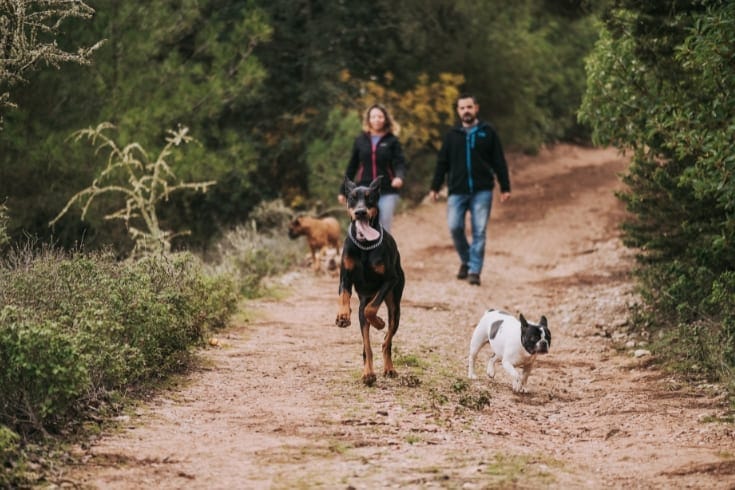
Using a hands-free leash can be a good way of training your dog to walk without a leash.
Hands-free leashes are popular with people who enjoy taking their dogs along when they go out jogging. Parents often find it easier to use a hands-free leash than try to juggle a small child and a dog.
Once the dog is obedient and will happily walk alongside you on his leash, you can unclip the leash from the belt and use the “heel” cue to keep your dog trotting along next to you.
Does It Matter How You Hold Your Dog’s Leash?
Now that you know how to hold your dog’s leash, you might be wondering why that even matters.
Well, there are a few reasons why holding your dog’s leash correctly is important:
- If you drop the leash, your dog will get loose. Loose dogs are a liability and pose a risk to everyone around them.
- Your dog might pull hard enough on the leash to pull you right over, potentially causing serious injury, including broken bones, torn ligaments, and sprained tendons in your arm, hand, or wrist.
- You could lose control of your dog but remain attached to him, which potentially places both of you in a dangerous situation.
So, by keeping your dog firmly attached to you using one of the grips outlined above, you’ll help to keep both of you safe.
Senior Dog Walkers
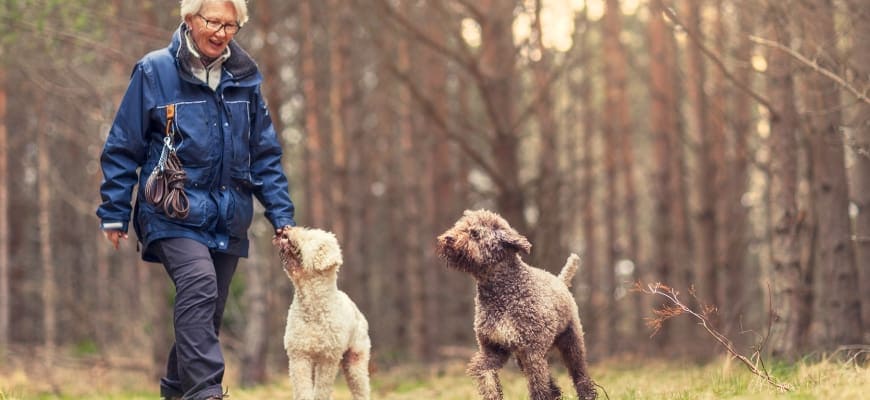
It’s no surprise to learn that senior dog walkers are most at risk of injury from unruly pups.
If you are a senior and you’re concerned that your dog might pull you over, you might consider using a hands-free leash. Using that style of leash can reduce the likelihood of leash accidents since it gives you more control and security while walking your pup.
Elderly dog walkers can sometimes find round rope leashes easier to hold in arthritic hands than flat nylon leashes.
Reactive Dogs
If you have a reactive dog, you might need some additional help with controlling your pup.
A reactive dog gets afraid or overexcited when exposed to certain triggers in the environment, such as joggers, bicycles passing by, strange dogs, or even kids in strollers. That can cause the dog to jump, pull, lunge, or bark frenziedly.
Owners of reactive dogs often find that using a front-attach, no-pull harness, or a headcollar rather than a shoulder-attach harness or regular flat collar can provide more control over a difficult dog.
We stress the importance of ensuring your dog’s harness or headcollar fits correctly and that he understands how it works before you use that type of leash out on walks.
Types Of Dog Leash Material
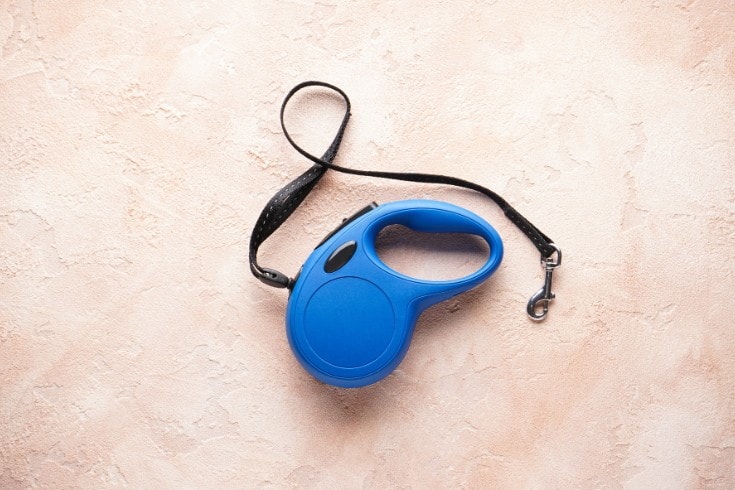
Holding a dog leash must be comfortable for the pup’s handler. The last thing you want is to get blisters or friction burns from your dog’s leash!
Let’s take a look at some of the different types of material dog leashes are made from.
Nylon
Nylon dog leashes are the most common choice of dog leash material for most dog owners.
Nylon leashes are pretty inexpensive, come in various shapes, are machine washable, and are strong and weather resistant. Choose a leash that’s easy and comfortable for you to hold using your preferred leash grip.
Sometimes a nylon leash can be too thick for you to grab a few layers of leash comfortably in your fist. However, if the leash is too thin, that can pinch or even cut your skin if the dog pulls or lunges.
Most dog owners find that a 1 or ⅝-inch nylon leash is the most comfortable for everyday walking.
Cotton
Cotton, rope-style leashes are affordable, lightweight, soft, and flexible. You can buy rope leashes in various colors, lengths, and styles, making them a popular choice.
I used a cotton rope with reflective leash components for my old dog since we often walked along a quiet lane to a field where she could enjoy some off-leash exercise. The reflective element of the leash ensured we were visible to traffic, helping to keep us both safe on early morning and evening walks.
The main downside of cotton rope leashes is that they are highly absorbent, making it easy for the leash to absorb liquid, such as rainwater and even urine. That can make for a very soggy, heavy leash by the end of a walk on a wet day or over dewy grass.
Cotton rope leashes are also not chew-proof, so if your dog doesn’t understand proper leash etiquette, a rope leash is probably not the best choice.
Chain or Cable

If you have a dog that bites his leash, a chain or cable can be a good solution and can make a good training aid if you’re teaching your dog not to chew his leash.
Chain leashes are made from metal, making them much heavier than other leash types. This kind of leash has a leather or nylon handle for the handler’s comfort. In addition, if you leave a metal leash outside, it will quickly rust. However, these leashes are extremely strong and last for years if properly cared for.
Cable leashes are pretty expensive and aren’t especially flexible, making them uncomfortable to use. That said, a cable leash can make an excellent tie-down for home use.
Leather
Leather dog leashes are quite popular and are available in a range of weights, lengths, and thicknesses. Leather often feels more comfortable in the hand than nylon or chain.
However, leather leashes can be extremely attractive to dogs that love to chew, and they can be quite pricey. Leather is difficult to clean, especially after a muddy walk, and the material is not especially weather-resistant. So, you’ll need to keep your leather leash out of direct sunlight and in a dry place where it won’t get damp.
Rubber
You can also find leashes that are made from rubber or elasticated materials. This kind of leash is designed to ease the pressure of the leash on the handler and the dog when the pup pulls or lunges suddenly.
Rubber leashes aren’t suitable for use with a strong puller, and rubber tends to be less long-lasting and more durable than other materials. For that reason, we recommend you choose a leash that includes nylon as well as rubber to give the leash extra strength.
FAQs
In this part of our guide, we answer some of the most commonly asked questions about how you hold your dog’s leash.
Q: Which hand do you hold a dog’s leash in?
A: You should hold your dog’s leash in the opposite hand to the side on which your dog is walking. So, if you hold the leash in your right hand, your dog should be walking on your left side.
Q: What is the proper way to hold a dog?
A: If you need to pick up your dog and hold him, put one arm around the front of the dog’s chest, under his neck, and your other arm around the dog’s back legs and under his rump.
Lift your dog up by straightening your legs so you don’t strain your back. Never pick your dog up by the scruff of his neck.
Q: How do you hold a long leash?
A: A long leash is between 10 and 15 feet in length. Coil the leash into loose loops and hold it in your hand on the opposite side of the side your dog is walking on. That should leave you with a shorter, regular leash length.
When you want to allow your dog more freedom for training purposes, simply uncoil some of the loops.
Q: Why is it important to hold your dog’s leash in a specific way?
A: Holding your dog’s leash is essential for keeping you and your dog safe and ensuring your pooch is always under control.
Q: Should dogs always be leashed during walks?
A: Many states and cities have strict leash laws in place. That means you need to keep your dog leashed and observe the proper leash protocols while on walks to keep on the right side of the law.
Leash laws are in place to keep you, your dog, and the general public safe. Many state parks also have a leash law, so the only place your dog can run off-leash is in a dog park.
Q: Is it bad for dogs to pull on a leash?
A: It’s not desirable for a dog to pull on his leash. Not only is walking a confirmed puller unpleasant and tiring, but it can also be dangerous if the dog pulls you over and gets loose.
Q: Should you drag your dog if he doesn’t want to walk on a leash?
A: Attempting to drag your dog along behind you if he won’t walk on the leash is counterproductive. The dog will naturally attempt to pull back against you, and you’ll end up getting nowhere.
Instead, encourage your dog to walk to heel alongside you by offering your furry friend high-value treats. Keep the leash loose so that your dog has nothing to pull against.
Q: What are some common leash-holding mistakes?
A: Common leash handling issues include:
- Putting the whole of your hand through the leash loop.
- Wrapping the leash around your hand, wrist, or arm.
- Fixing the leash to the belt loop on your pants or belt.
- Carrying a cell phone or purse in your anchor hand.
- Holding your dog too close to your body with a tight leash.
- Holding the leash high in the air when the dog moves close to you to remove the slack from the leash.
You should also be careful not to allow the leash to get so long that your dog can weave around in front of you, putting you in danger of tripping over your furry friend!
Final Thoughts
Did you enjoy our guide explaining how to hold a dog leash? If you did, please take a moment to share the article with other readers.
There are several ways in which you can hold your dog’s leash. The method you choose depends on how your dog behaves on the leash and on your personal preference. When choosing a leash, pick one that’s made from a material that’s strong, durable, and comfortable to hold.
How do you prefer to hold your dog’s leash? Tell us your preferred technique in the comments box below!
